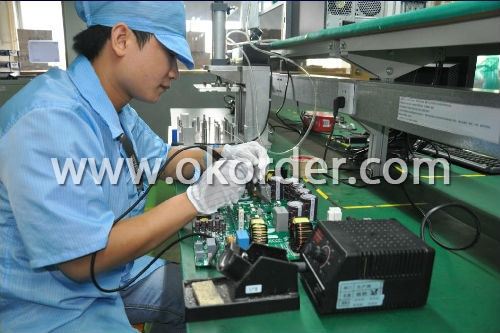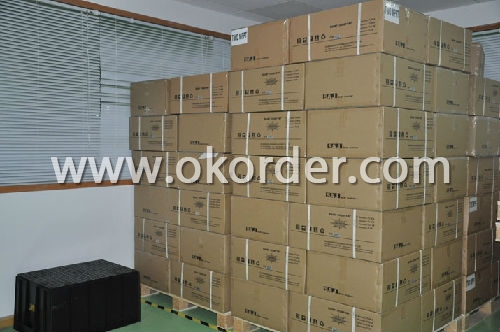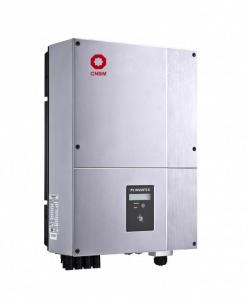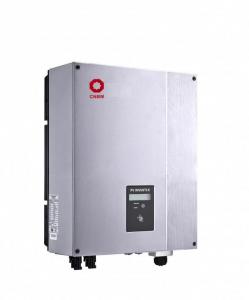Hyundai Solar Inverter CNBM-4200MTL Grid Tied Solar Inverter
- Loading Port:
- ShenZhen
- Payment Terms:
- TT
- Min Order Qty:
- 1 unit unit
- Supply Capability:
- 3000 per month unit/month
OKorder Service Pledge
OKorder Financial Service
You Might Also Like
Features of Grid Tied Solar Inverter CNBM-4200MTL
The full range of CNBM single phase inverters has received VDE, CE, G83/1, G59/2, ENEL2010, VDE4105, C10/C11, AS4777 etc.
With a R&D team more than 100 engineers,40% of the staff, who has been deeply engaged in the photovoltaic industry for 10 years, CNBM takes the mission to increase the inverter availability and efficiency, putting continuous innovation to make CNBM inverter easier for installation and operation, and more cost-effective for solar plant construction.Maximum efficiency of 97.8% and wide input voltage range, Internal DCswitch,MTL-String, Sound control,Bluetooth/RF technology /Wi-FiTransformerless,GT topology
Technical data of Grid Tied Solar Inverter CNBM-4200MTL
Model | CNBM-3600MTL | CNBM-4200MTL | |
Input data (DC) |
|
| |
Max. DC power | 3800W | 4200W | |
Max. DC voltage | 600V | 600V | |
Start voltage | 150V | 150V | |
PV voltage range | 100V-600V | 100V-600V | |
Max. input current | 10A | 15A | |
Number of MPP trackers /strings per MPP tracker | 2/2 | 2/2 | |
Output (AC) |
| ||
Rated AC output power | 3600W | 4200W | |
Max. AC power | 3600W | 4200W | |
Max. output current | 18A | 21A | |
Power factor | 1 | 1 | |
THDI | <3% | <3% | |
AC connection | Single phase | Single phase | |
Efficiency |
| ||
Max. efficiency | 97.6% | 97.9% | |
Euro weighted efficiency | 97% | 97.4% | |
MPPT efficiency | 99.5% | 99.5% | |
Protection devices |
| ||
Output over voltage protection-varistor | yes | yes | |
Ground fault monitoring | yes | yes | |
Grid monitoring | yes | yes | |
General Data |
| ||
Dimensions (W / H / D) in mm | 360/510/188 | 360/510/188 | |
Weight | 24KG | 24KG | |
Operating temperature range | –25°C ... +60°C | –25°C ... +60°C | |
Altitude | 2000m(6560ft) without derating | ||
Self-Consumption night | < 0.5 W | < 0.5 W | |
Topology | Transformerless | ||
Cooling concept | Natural | Natural | |
Environmental Protection Rating | IP65 | IP65 | |
Features |
| ||
DC connection | H4/MC4(opt) | H4/MC4(opt) | |
Display | LCD | LCD | |
Interfaces: RS485/RS232/Bluetooth / RF/Zigbee/Wifi | yes/yes/opt/opt/opt | ||
Warranty: 5 years / 10 years | yes /opt | ||
Certificates and approvals | CE、VDE 0126-1-1、DK5940、G83/1-1、G59/2、RD1663、EN50438、 VDE-AR-N4105、CEI-021、IEC-62109、ENEL-Guide | ||
CNBM-4200MTL is simple national setting of line supply monitoring, Easy country configuration, with Multi-language,display, currently available for most of the countries over the world.With technical creativity and scientific management, the factory established first class R&D and test centers, as well as management and R&D teams comprising of PhDs and masters with overseas qualification.
Figure 1 the application of Grid Tied Solar Inverter CNBM-4200MTL

Figure 2 The Stock of Grid Tied Solar Inverter CNBM-4200MTL

- Q: Can a solar inverter be used in conjunction with a backup generator?
- Yes, a solar inverter can be used in conjunction with a backup generator. In a hybrid system, the solar inverter manages the flow of electricity from both the solar panels and the backup generator, ensuring a seamless transition between the two power sources. This allows for continuous power supply even when solar energy is not available, providing an efficient and reliable solution.
- Q: What is the role of an anti-islanding function in a solar inverter?
- The role of an anti-islanding function in a solar inverter is to ensure the safety of electrical grid workers by preventing the solar inverter from continuing to generate and supply power to the grid during a power outage. This function is crucial as it helps avoid the risk of injury or damage to utility workers who may be repairing or working on the grid. By detecting the loss of grid power, the anti-islanding function quickly disconnects the solar inverter from the grid, preventing any power feedback and ensuring that the grid remains stable and isolated.
- Q: Can a solar inverter be used with different types of solar panels (monocrystalline, polycrystalline, thin-film)?
- Yes, a solar inverter can be used with different types of solar panels, including monocrystalline, polycrystalline, and thin-film. The key factor is that the solar panels need to have compatible voltage and current ratings with the inverter. As long as the specifications match, the inverter can efficiently convert the DC power generated by any of these solar panel types into usable AC power for various applications.
- Q: What is the role of a solar inverter in preventing system failures?
- The role of a solar inverter in preventing system failures is to convert the direct current (DC) electricity generated by solar panels into alternating current (AC) electricity that can be used to power homes and businesses. In addition to this conversion, solar inverters also play a crucial role in ensuring the stability and efficiency of the entire solar power system. They monitor and regulate the voltage and frequency of the electricity being generated, protecting the system from overvoltage, undervoltage, and other electrical abnormalities that can potentially lead to system failures. By constantly monitoring and adjusting the electrical output, solar inverters help maintain the health and reliability of the solar power system, ultimately preventing potential failures and maximizing the overall performance.
- Q: What is the role of a solar inverter in net metering?
- The role of a solar inverter in net metering is to convert the direct current (DC) electricity produced by solar panels into alternating current (AC) electricity that can be used to power homes or businesses. It also allows any excess electricity generated to be fed back into the grid, enabling net metering and allowing the owner to receive credits or compensation for the excess energy provided.
- Q: Can a solar inverter be used with any type of solar panel?
- No, a solar inverter cannot be used with any type of solar panel. The compatibility between the solar inverter and solar panel depends on the type of technology used in the solar panel, such as monocrystalline, polycrystalline, or thin-film. It is essential to match the specifications and voltage requirements of the solar inverter with the solar panel to ensure efficient and safe operation.
- Q: How does a solar inverter impact the overall system reliability?
- A solar inverter plays a crucial role in the overall system reliability of a solar power system. It converts the direct current (DC) generated by solar panels into alternating current (AC) that can be used to power homes and businesses. By efficiently managing the power output and ensuring proper voltage levels, a solar inverter helps maintain the stability and reliability of the system. It also includes protective features that safeguard the system from potential issues like overvoltage, overcurrent, and short circuits. Therefore, a high-quality solar inverter positively impacts the overall system reliability by ensuring optimal performance and protecting against potential faults or failures.
- Q: What is the power factor correction capability of a solar inverter?
- The power factor correction capability of a solar inverter refers to its ability to correct any power factor issues in the electrical system it is connected to. A solar inverter typically aims to achieve a power factor as close to 1 as possible, which indicates a balanced and efficient use of electrical power. By actively monitoring and adjusting the power factor, a solar inverter ensures that the energy generated from the solar panels is effectively utilized and does not cause any unnecessary strain on the electrical grid.
- Q: What is the difference between a grid-tied and off-grid solar inverter?
- A grid-tied solar inverter is connected to the local utility grid and allows for the transfer of excess energy generated by the solar panels back to the grid. This type of inverter does not have the capability to store energy and requires a constant grid connection to function. On the other hand, an off-grid solar inverter is designed to be used in systems that operate independently from the utility grid. It is typically used in remote areas or locations where grid connection is not available. These inverters have the ability to store excess energy in batteries for later use when there is no solar generation.
- Q: Can a solar inverter be used with a net metering system?
- Yes, a solar inverter can be used with a net metering system. In fact, a solar inverter is a crucial component of a net metering system. It helps convert the direct current (DC) electricity produced by the solar panels into alternating current (AC) electricity that can be used to power homes or businesses. The excess electricity generated by the solar panels is then fed back into the grid through the net meter, allowing consumers to receive credits or compensation for the surplus energy they produce.
Send your message to us
Hyundai Solar Inverter CNBM-4200MTL Grid Tied Solar Inverter
- Loading Port:
- ShenZhen
- Payment Terms:
- TT
- Min Order Qty:
- 1 unit unit
- Supply Capability:
- 3000 per month unit/month
OKorder Service Pledge
OKorder Financial Service
Similar products
Hot products
Hot Searches
Related keywords




























